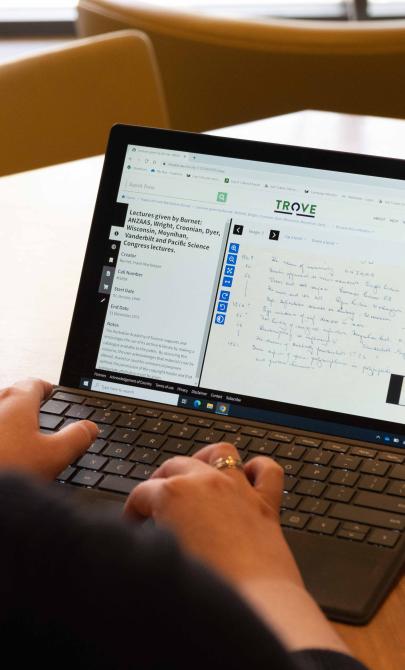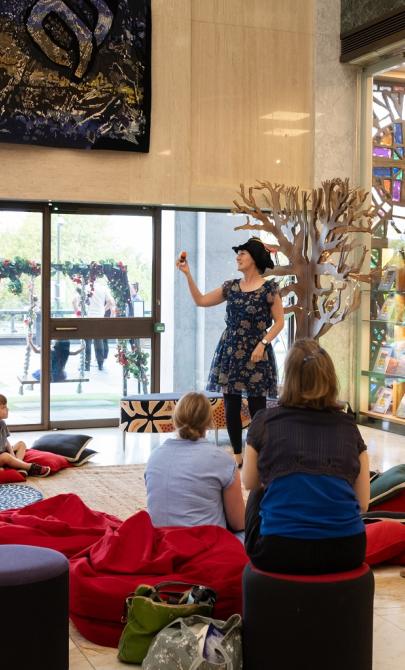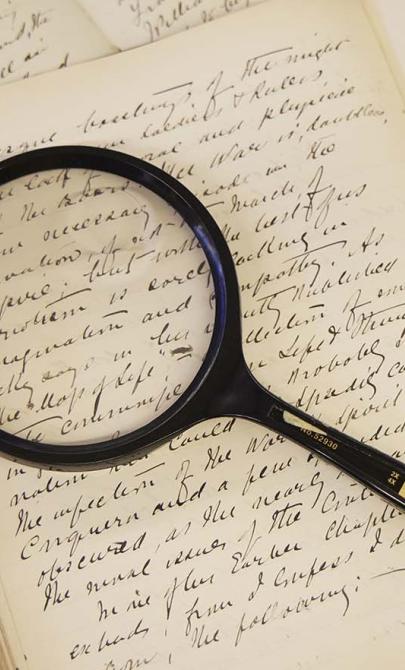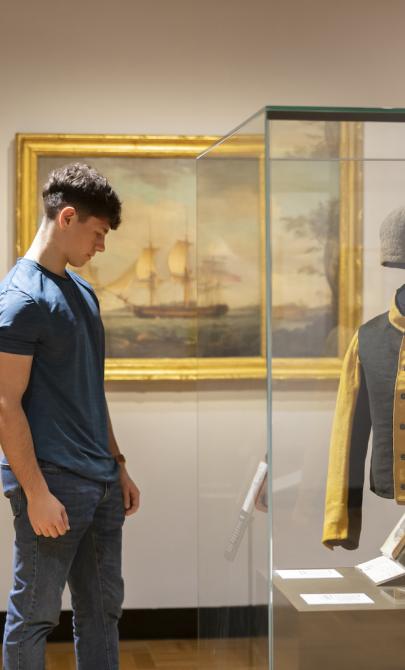Essay: ‘I’m Captain Cooked’: Aboriginal perspectives on James Cook, 1770-2020
John Maynard
Professor John Maynard is a Worimi man from the Port Stephens region of New South Wales. He is the Director of the Purai Global Indigenous and Diaspora Research Studies Centre and one of the world’s most respected voices on Indigenous history. He has written widely on issues ranging from military involvement to political activism and sport, and published titles with the National Library of Australia including 'True Light and Shade: an Aboriginal Perspective of Jospeh Lycett’s Art' and 'Living with the Locals: Early Europeans’ Experience of Indigenous Life'.
Essay reproduced from Cook and the Pacific.
In 2020 the Australian nation will be torn between Anglo celebrations and Aboriginal mourning of James Cook’s so-called discovery of Australia. In raising the British flag on Possession Island in the Torres Strait, Cook unleashed cataclysmic consequences upon Aboriginal people of the Australian continent. As an Aboriginal historian, one cannot but recognise, in the wake of this single event, the horrific impact and cultural destruction that would explode across the continent in the decades ahead. At its height, the Aboriginal population would teeter on near complete annihilation through disease, warfare and severe government policies. I recognise that it would be completely unrealistic to think that we would have remained immune to outside invasion and its impact even if James Cook had not stepped ashore in 1770.
In this essay, I will undertake to provide an Aboriginal perspective on Cook that examines the complexities and contradictions of the man and his interactions with Aboriginal Australia, and the impact he has had. While there has been much written about Aboriginal stories, songs, humour and derision of Cook in remote Australia, this essay will focus on how James Cook has been remembered in south-eastern Australia. The symbolic use of James Cook by Aboriginal people is widely evident; when Ray Rose, an Aboriginal Elder originally from Dirranbandi in south-western Queensland, was asked about his health after suffering a stroke, he responded, ‘Naw, not too good, I’m Captain Cooked’.
Divisions within Australia over differing viewpoints on the navigator James Cook have already begun to erupt over historical memory and its accuracy. In a recent article, Aboriginal journalist Stan Grant noted the divisive fractures within the United States over the commemoration of Southern leaders of the Civil War period and demands that the memorials be pulled down. After a walk through Hyde Park in Sydney, Grant drew attention to similar statues in Australia. He noted the monument dedicated to James Cook and its inaccuracy in stating that Cook had discovered Australia. Grant had no idea that his comment would incite such a backlash of heated opposition. He was not calling for the statue to be torn down, nor suggesting that Cook’s memory should be devalued. Grant simply asked for an amendment to be made on the plaque to recognise what is now scientifically recognised as over 65,000 years of Aboriginal connection to the continent. Grant recognised that Cook was not simply ‘a figure cast in bronze - a statue - but the man James Cook; a man of doubt and fear and perseverance and undoubted courage’.
I am, like Grant, an admirer of James Cook as a skilled navigator and an inspiring leader of his crews. Cook’s working-class upbringing instilled in him a capacity to view the world through a different lens, and he was instrumental in fostering loyalty in the crews that sailed under him. In 2014 I went on board the Endeavour replica at the Australian National Maritime Museum at Darling Harbour. I was struck by what an achievement it was to sail such a tiny craft across such a vast distance and through some terrifying seas. But what of his journey to Botany Bay and his orders in relation to Aboriginal people? Cook had received secret instructions from the British Admiralty, and as such from the Crown itself, which advised that in the event he found the continent, he should chart its coasts, obtain information about its people, cultivate their friendship and alliance, and appropriate any convenient trading posts in the King’s name. But clearly Cook did not open up any meaningful dialogue or discussion, nor did he gain any consent in claiming the entire east coast of the continent. As such he was in direct violation of his orders from the Crown. In fact, the evidence that can be gleaned from his own records clearly implies the opposite: as Cook sets down in his journal, ‘all [the Aboriginal people] seem’d to want was for us to be gone’. There was no welcome mat of consent rolled out. The arrogance of Cook’s actions in claiming possession of the continent without any alliance with, or consent from, the owners, and the ignorance on his part that this suggests, stands in stark contrast to his glowing written record which speaks of a paradise of equality:
Cook and his impact upon Aboriginal Australia has been widely incorporated into Aboriginal songs, stories and understandings in the aftermath of 1770. Anthropologist Deborah Bird Rose’s books Hidden Histories and Dingo Makes Us Human, Japanese historian Minoru Hokari’s Gurindji Journey and, even more recently, celebrated author Peter Carey’s A Long Way from Home are just a few of the works that have drawn attention to the residual Aboriginal memory of James Cook. These accounts feature Aboriginal people in northern and remote Australia stating that James Cook had visited their communities and had been shooting people, raping their women and taking the land. Cook’s impact was clearly far reaching, and its memory persistent. Of course, we know that he did not visit Central Australia or the Kimberley, but this recognition illustrates how deeply the event has been burned into Aboriginal consciousness.
But it is not just Central Australia and the Kimberley where Cook’s memory has resonated so powerfully, and continues to do so. Communities in south-eastern Australia, where Cook most certainly did have a direct impact, have maintained and built Cook into their understandings of the past and everyday language. Sandy Cameron, a Yagirr Elder on the north coast of New South Wales, was interviewed by linguist Terry Crowley in 1973 and recorded a song in language of Cook’s visit. Cameron explained:
I told this fellow there was this Captain Cook. He was the King of the tribe and had all this tin stuff and plonk and tobacco. All the dark people had a look. He’s a wuyirribin … wuyirribin that’s a boat … That’s a ship coming in … and they say warrayi who this ship coming in? And Captain Cook shouldn’t have bowed the boat with the bush … just as much to say he’s a friend, friend coming in. He jumped in a little boat … when he paddled in, he left the big boat outside … big sailing you know? Walked in waving, the chief of the tribe went to them with boomerang and spears. No … he said wanha, wanha STOP.
Chief said I’ll stop all of them with the spear and the boomerang. Made friends, givem tobacco and clay pipe. You don’t buy them anymore. Penny each one time, shilling a dozen. And fed alright, shook hands made friends. And they was there… and this is a song I made up myself.
Sandy Cameron then broke into a song, in lingo, about Cook and his coming ashore. In stating firmly that ‘Captain Cook shouldn’t have bowed the boat with the bush’ and that the old chief had called out ‘No … wanha, wanha STOP’, the message conveyed is that Cook and his crew initially should not have come ashore.
The Yuin people on the south coast of New South Wales retained oral memories that recognise the lack of any formal consent or contact with Cook. In Umburra Cultural Centre’s unpublished manuscript View from the Mountain, they noted that ‘Cook’s maps were very good, but they did not show us our names for places. He didn’t ask us’. Aboriginal people across New South Wales derisively sung songs lampooning James Cook. In Armidale, good friend Ray Kelly recalled, they converted a young children’s school rhyming song into their own dirty ditty:
Captain Cook chased a chook all around Australia
He slipped on a rock
And split his cock-a-doodle-dandy.
Similar songs were sung at the Karuah mission near Port Stephens. Ray Kelly informed me that as a kid on ‘the Mish’ at Armidale he knew older people who when they spotted a welfare officer, or even an unknown ‘Gubba’, would say, ‘Lookey, lookey, here comes Cookey’. The humour and retained bitter memory of James Cook, and what he represents, remain etched deeply within the fabric of many Aboriginal communities on the east coast of Australia. Cook is still at the top of the heap of historical bogeymen. As I have stated elsewhere, Cook ‘transcends time and space to wreak havoc across the continent upon the Aboriginal inhabitants over the course of the past 250 years’. Whether he deserves this monster mantle is open to conjecture and challenge from wider non-Indigenous Australia, but from an Aboriginal perspective Cook remains the scapegoat for white invasion.
Learning activities
- Investigate the relationship between the actions of Cook and the Endeavour crew in 1770, and the subsequent British arrival to set up a penal colony in 1788. What is the connection between these events?
- Maynard writes that he is an admirer of Cook as a navigator and leader, but is critical of his actions in relation to Aboriginal people. Discuss this type of ‘compartmentalisation’ of Cook and his story. What are some other points of view? Consider the changed way of life for Indigenous Australians where ‘settlement’ occurred and the ways this might have contributed to Cook’s ‘historical bogeyman’ status.
- As Maynard shows, ‘Lookey, lookey, here comes Cookey’ became a catchcry for the arrival of any form of government representative into an Aboriginal community. Evaluate what this might mean in a community where children were being closely monitored for school attendance. What outcomes might be implied in this phrase?
- Cook in 1770 was a man; Cook today exists in the realm of myth. He has been represented in the West in myriad ways over time: in novels, art and textbooks, and on film and TV. Cook also exists in many forms in the stories of Indigenous communities, both those he met and those he did not. Compare and dissect a set of stories, depictions or myths relating to Cook. You might like to compare European or Indigenous stories, or stories from two geographically separate Indigenous communities.
- Australia is a vast country and is home to a large number of Indigenous nations. Consider the fact that each nation has a different cultural and linguistic heritage, and that some nations never encountered Cook directly and may not even have met other Europeans until much later. What impact could this have on achieving a united, national approach to the historiography of Cook and the arrival of Europeans in Australia?



